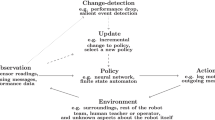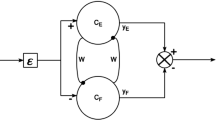Abstract
This paper proposes a unique oscillator-based robot controller with learning abilities to effectively guide a team of robots operating in uncertain environments. To verify this, we designed four separate controllers and compared their performance in a series of tests in several different environments. The experiments used a team of three robots to explore arenas with variable lighting and different obstacle patterns, with a goal of having the team as a whole absorb as much light as possible. The four controllers were: a reactive controller, an oscillator with fixed parameters, an oscillator whose parameters changed based on the pattern of sensor information received, and an oscillator-based controller that used reinforcement learning. Experiments confirmed that the proposed method outperforms the others in all environments tested.
Similar content being viewed by others
References
Orlovsky, G.N., Deliagina, T.G., Grillner, S.: Neuronal Control of Locomotion: from Mollusc to Man. Oxford University Press, Oxford (1999)
Aoi, S., Tsuchiya, K.: Locomotion control of a biped robot using nonlinear oscillators. Auton. Robots. 19(3), 219–232 (2005). doi:10.1007/s10514-005-4051-1
Iida, S., Kondo, T., Ito, K.: An environmental adaptation mechanism for a biped walking robot control based on elicitation of sensorimotor constraints, from animals to animats 9. In: Lect. Notes Comput. Sci., vol. 4095, pp. 174–184. Springer (2006)
Quinn, R.D., Espenschied, K.S.: Control of a hexapod robot using a biologically inspired neural network. In: Beer, R. D., Ritzmann, R.E., McKenna, T. (eds.) Biological Neural Networks in Invertebrate Neuroethology and Robotics, pp. 365–381. Academic Press, San Diego, California, ISBN 0-12-084728-0 (1993)
Sfakiotakis, M., Tsakiris, D.P.: Neuromuscular control of reactive behaviors for undulatory robots. Neurocomputers 70(10–12), 1907–1913 (2007)
Lu, Z., Ma, S., Li, B., Wang, Y.: Design of a snake-like robot controller with cyclic inhibitory CPG model. In: 2005 IEEE International Conference on Robotics and Biomimetics (ROBIO), pp. 35–40 (2005)
Olfati-Saber, R.: Swarms on sphere: a programmable swarm with synchronous behaviors like oscillator networks. In: 2006 45th IEEE Conference Decision and Control, pp. 5060–5066 (2006)
Olfati-Saber, R., Fax, J.A., Murray, R.M.: Consensus and cooperation in networked multi-agent systems. Proc. IEEE 95(1), 215–233 (2007). doi:10.1109/JPROC.2006.887293
Wischmann, S., Hülse, M., Knabe, J.F., Pasemann, F.: Synchronization of internal neural rhythms in multi-robotic systems. Adapt. Behav. 14(2), 117–127 (2006), Adaptive Behavior—Animals, Animats, Software Agents, Robots, Adaptive Systems
Duijn, M., Keijzer, F., Franken, D.: Principles of minimal cognition: casting cognition as sensorimotor coordination. Adapt. Behav. 14(2), 157–170 (2006). doi:10.1177/105971230601400207
Hülse, M., Wischmann, S., Pasemann, F.: Structure and function of evolved neuro-controllers for autonomous robots. Connect. Sci. 16(4), 249–266 (2004). doi:10.1080/09540090412331314795
Watanabe, K., Izumi, K., Maki, J., Fujimoto, K.: A fuzzy behavior-based control for mobile robots using adaptive fusion units. J. Intell. Robot. Syst. 42(1), 27–49 (2005). doi:10.1007/s10846-004-3025-4
Pearce, J.L., Powers, B., Hess, C., Rybski, P.E., Stoeter, S.A., Papanikolopoulos, N.: Using virtual pheromones and cameras for dispersing a team of multiple miniature robots. J. Intell. Robot. Syst. 45(4), 307–321 (2006). doi:10.1007/s10846-006-9038-4
Arkin, R.: Behavior-Based Robotics. MIT, Cambridge, MA (1998)
Gu, D., Yang, E.: Fuzzy policy reinforcement learning in cooperative multi-robot systems. J. Intell. Robot. Syst. 48(1), 7–22 (2007). doi:10.1007/s10846-006-9103-z
Clark, M.R., Anderson, G.T., Skinner, R.D.: Coupled oscillator control of autonomous mobile robots. Auton. Robots 9(2), 189–198 (2000). doi:10.1023/A:1008922502387
Qi, B.H., Anderson, G.T.: A systematic approach to parameter design for a coupled oscillator controller. In: IEEE International Conference on Robotics and Automation, Seoul (2001, April)
Anderson, G.T., Cheng, G.: A sensor-based robot controller for autonomous exploration of unknown environments. J. Intell. Autom. Soft Comput. 9(2), 113–120 (2003)
Sutton, R.S., Barto, A.G.: Reinforcement Learning. MIT, Cambridge, MA (1998)
Fernández, F., Borrajo, D., Parker, L.E.: A reinforcement learning algorithm in cooperative multi-robot domains. J. Intell. Robot. Syst. 43(2–4), 161–174 (2005)
Gu, D., Hu, H.: Integration of coordination architecture and behavior fuzzy learning in quadruped walking robots. IEEE Trans. Syst. Man Cybern., Part C Appl. Rev. 37(4), 670–681 (2007)
Kulkarni, P., Goswami, D., Guha, P., Dutta, A.: Path planning for a statically stable biped robot using PRM and reinforcement learning. J. Intell. Robot. Syst. 47(3), 197–214 (2006). doi:10.1007/s10846-006-9071-3
Ng, Y., A.W., Harada, D., Russell, S.: Policy invariance under reward transformations: theory and application to reward shaping. In: Proceedings of the Sixteenth International Conference on Machine Learning (1999)
Author information
Authors and Affiliations
Corresponding author
Additional information
This material is based upon work supported in part by the U.S. Army Research Office under grant/contract number DAAG55-98-1-0011.
Rights and permissions
About this article
Cite this article
Anderson, G.T., Yang, Y. & Cheng, G. An Adaptable Oscillator-Based Controller for Autonomous Robots. J Intell Robot Syst 54, 755–767 (2009). https://doi.org/10.1007/s10846-008-9287-5
Received:
Accepted:
Published:
Issue Date:
DOI: https://doi.org/10.1007/s10846-008-9287-5




